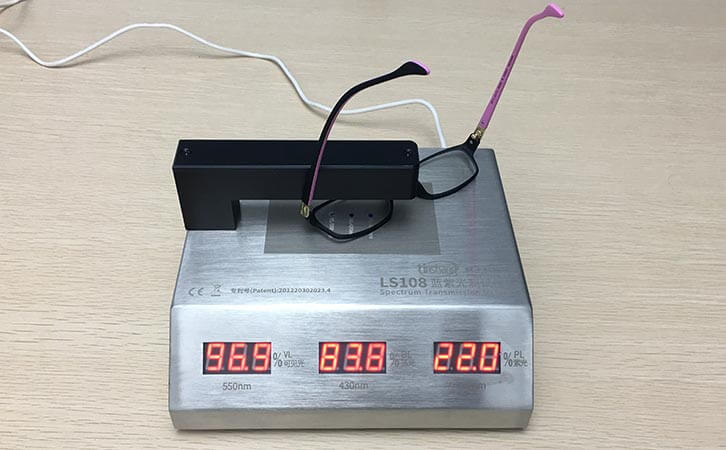Spectacle Lenses Anti-blue Effect Testing
With the development of electronic products, myopia is getting younger and younger. Regardless of whether it is equipped with contact eyes or frame glasses, we hope to match a pair of glasses that are good for our eyes. We often see shop assistants measure the blue-violet light of spectacle lenses with a spectrum transmission meter when they are wearing glasses. Use the data to explain which lens is expensive and which lens is cheap. So why do we test the blue-violet light of the spectrum transmission meter of glasses lenses?
1.The harm of blue light to the human eye
Blue light is abundantly present in computer monitors, mobile phones, fluorescent lights, digital products, LEDs and other light sources. So what harm does blue light do to our eyes? Blue light can cause damage to retinal cells and even cause vision loss. Among them, blue light with a wavelength of 400nm-460nm has the greatest damage to the eyes' retina. Therefore, the anti-blue light effect of the lens should be detected by a spectrum transmission meter .
Blue light has extremely high energy and can reach the lens directly to the retina. Causes light-sensitive cells to die. In severe cases, it can also cause macular degeneration and cataracts.
The wavelength of blue light is short. Focusing on a point in front of the retina can easily cause visual fatigue in the long term. As a result, energy cannot be effectively concentrated, which affects learning and work efficiency.
Blue light can make people sleep poorly. Blue light inhibits the secretion of melatonin. Melatonin promotes sleep and regulates jet lag.
2.The harm of purple light to the human eye
If blue light is more harmful to human eyes, then purple light is the most harmful to all eyes. The mosquito killer lamp usually installed in the community is the purple light. Welding arc, ultraviolet, etc. Prolonged exposure to purple light can cause acute damage to the eyes, resulting in corneal detachment. It can also cause macular degeneration. Therefore, the spectrum transmission meter is used to measure the purple light of the lens.
3.Use Linshang LS108 spectrum transmission meter to detect the anti-blue effect
Since blue-violet light is harmful to the human eye, a good pair of glasses must have high light transmission and block blue and purple light. It is recommended to use Linshang LS108 spectrum transmission meterto measure the anti-blue-violet light and transmittance effects of spectacle lenses. This instrument can measure blue light with a wavelength of 430nm, purple light with a wavelength of 395nm and visible light with a wavelength of 550nm. LS108 spectrum transmission meter is suitable for the test of spectacle lenses, PC materials, organic materials, coating materials, anti-blue light materials and other materials. The minimum test size for this material is 3mm. The spectrum transmission meter has the following characteristics:
The parallel light path design makes the measurement results more accurate and stable.
The instrument can measure visible light transmittance, purple light transmittance and blue light transmittance in one device.
The instrument is a stainless steel bench-top design with a beautiful appearance that is convenient for the operation of the measured object.
3mm test aperture, suitable for small size test materials.
The instrument has a real-time dynamic self-calibration function, automatically calibrated to 100% transmission after power-on.
Linshang Technology has good after-sales service, if you have any questions, you can consult us by calling +86 13510633052!
- Features of the LS183 UV Transmittance Meter
- Difference between Visible Light Transmission Meter LS183 and LS108H
- Spectacle lens anti-blue light detection---blue-violet light transmittance meter
- Spectrum Transmission Meter for Measuring PC Sheet
- Difference between LS103A and LS183 spectrum transmission meter
- Measuring the Transmittance of a Hemisphere by Plastic Transmittance Meter
